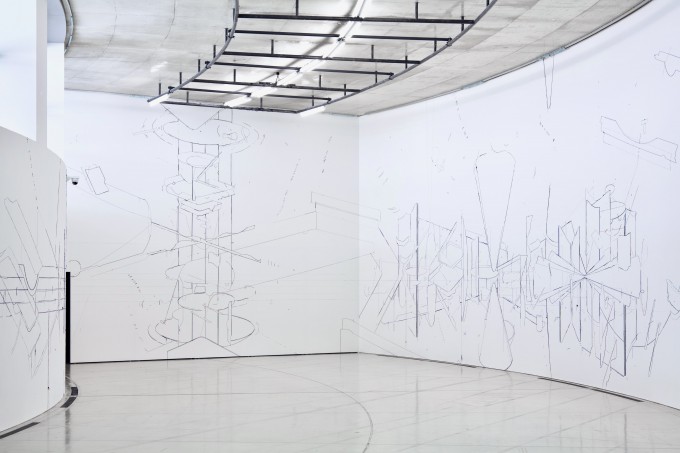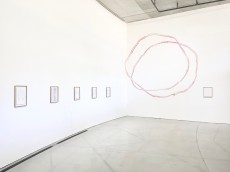
(MO)TION
Incomplete lines in the air
ITO Satoko
MORI Keita’s drawings made in accordance with the condition of the architectural space and the site made an unrestricted expansion in this program ranging from a drawing series on paper with eye-catching delicate figures to the wall drawing that was freely developed toward the back wall along the arc-shaped gallery. On a sheet of paper with a limited space, the drawing is eventually completed, but for the wall drawing, how far space will be used remains undecided and it continues to grow in a progressive form. The material he uses is light being able to cover the wall at a relatively fast speed, and the drawn lines sometimes approach the space away from the support, so that the viewer can experience a feeling of going into the drawing that expands without an end. Represented in the space is a systematic huge structure, and approaching to look at it, the viewer will find that the material is thread of our daily necessities.
Mori’s drawings are made with thread. The nuances felt in “drawing”, such as speed, strength and softness are not in thread, and there are only two ways for the lines between points; tightening or loosening, and straight or curved. As for curves, gravity, natural uncontrollable power, affects them, and there are countless types of lines, depending on how much they are loosened. He makes it a rule to paste thread in such conditions using a glue gun, and improvises his drawing.
Lines drawn with threads different in color and thickness do not necessarily form a surface with connected dots, and threads are left as they are, though they make us expect to see the finished shape. Tangled threads and traces of glue caused by the manual work are important elements of the work. The title “bug report” is a message that appears on a computer screen to inform you of program errors or defects. The tangled threads and traces left on the huge structure-like drawing are compared to a system error on a computer. In any highly controlled system, it can hardly be said that there is no possibility of an error. There are questions for the convenience given and guarantee of security in the seemingly complete world, and what made Mori realize such questions was the great earthquake in Fukushima in his faraway motherland when he was studying in Paris, which he witnessed as information. The collapse of public order that had been assured until then made the artist accept the chaos hidden in this world. It led him to express in his thread drawing series that there was something complex and moving disorderly in the world that seemed to be in order.
The unexpectedness that thread, whose primary use of sewing has been totally altered by a simple act of pasting to form a large structure, strengthens the presence of errors involved in the system and draws people’s attention by slowly bringing up social aspects.
Although the work is drawn extemporaneously by pasting and considered to differ completely from a world constructed on strict calculation, the drawing reminds the viewer of many different things such as a system structure, building design drawing and the unknown universe. These things include information that spreads in our daily lives like bubbles and can be compared to a system that grows with information. The difference between thread and paint or pencil that we usually use for drawing as material is that thread already exists as a style of work, and at the same time, it plays the role of a material to depict new figures. Thread hanging down or tangled off the wall sometimes shows its original form apart from being a line of the drawn figures. The thin and relatively weak nature of the material itself, along with the intricately combined figure images, represents the delicacy and transience of the structure, which causes erroneous operation even with one mistake. While thread can form shapes on the wall in this method of drawing, it suggests a multilayered relationship between its own existence and those figures.
What this material tells us, on the other hand, is a history of the thread that has been indispensable to the development of culture, including the example that became the name of a former trade route, and human creativity. Even though its shape does not change greatly, the thread sews up objects and has formed new shapes at a place familiar to people. In the expression of Mori’s drawings, the thread is a material almost symbolizing the origin of civilization while revealing the structure of society. From the root to the present——the thread’s great leap between two poles would be the reason for creating diverse imagination.
The linkage of contents and media included in the structure of Mori’s work is firm, and extends new discoveries and imaginations by mutually bringing out and multiplying their meanings. The universality is communicated to us today by tracing threads, and something that makes the world is abstractly expressed. Human imagination born there is unlimited.
〇動
2018年10月27日(土)-12月9日(日)10:00- 18:00、会期中無休、無料
盛 圭太
MORI Keita

≪Bug report≫(Ritournelle)
宙にある未完の線
伊藤 聡子
建築空間や場の条件に呼応しドローイングを制作していく盛圭太の作品は、本プログラムの展示では、紙に描かれた繊細な図像が目を引くシリーズからウォールドローイングへ、弧を描くギャラリーを進んで見えてくる奥の壁へ向かって自在な広がりを見せた。予め範囲が決まっている紙の上では一つの完結が示されるが、ウォールドローイングは空間をどこまで使うかは未定のまま、進行形で増え続ける。その素材は軽い性質ゆえに比較的早いスピードで壁を覆うことができ、描かれる線は時に支持体を離れて空間へアプローチし、鑑賞者は完成することなく広がるドローイングの中に入り込むかのような体験をすることが可能だ。場にはシステマティックで巨大な構造体が現れ、鑑賞者は近づいて見てみようとすると描かれている線が日用品の糸であることに気づかされる。
盛のドローイングは糸で描かれる。速さ、強弱、柔らかさといったいわゆる線描に表れるであろう描き手によるニュアンスは糸にはなく、点と点の間の線は引っ張るか緩めてたるませるか、直線か曲線か、手法は2つに限られる。曲線に関しては、自分の力では描けない自然の力、重力が働き、どのくらい緩めるかにより無数の種類ができる。それらの条件を持つ糸をグルーガンで留めていくというルールを自らに課し即興で描いていく。
色や太さが異なる多種の糸で引かれた線は、必ずしも複数の点が結ばれて面を成形しているわけでもなく、形が完成されるのを予測させながらも「糸」のまま残されている。人の手によって貼り付けられることで所々に起きるもつれや接着剤の跡は、作品として重要な要素とされる。タイトルに使われる「バグリポート」とは、プログラムの誤りや欠陥を知らせるためにパソコンの画面上などに現れる表示のことだ。大きな構造体のようなドローイングに残された糸のもつれや跡は、ここではコンピュータにおけるシステムエラーに例えられる。どんな高度に管理されたシステムにもエラーを起こす可能性が無いとは言い切れないのではないか。完成されたように見える世界、与えられる利便性と安心の保証への疑問。それを気づかせたのは、盛がパリで在学中に、情報を通して目撃することとなった遠い祖国で起きた福島の震災だった。それまで保証されてきた秩序の崩壊は、潜んでいた世の中の混沌を作家に受け入れさせる。整然としているように見える世界には、実はもっと複雑で無秩序に動いている何かがあることを、糸を用いたドローイングシリーズで表そうとするきっかけとなった。
接着するだけの単純な行為によって本来の縫製という用途を一変させられた糸が、実は巨大な構造物を形作っているという意外性は、システムに内包されるエラーの存在感を強め、社会の様相をゆっくりと立ち上がらせて人を引き込む。
即興で貼り付けることで描かれ、厳密な計算をもとに構築される世界とは似ても似つかないと思わせるにもかかわらず、システム構造や建物の設計図、または未知の宇宙といった、鑑賞者によってドローイングから見えてくるものはまさに多様だ。それらは私たちの日常で次第に泡のように広がる情報であり、また情報につれて増殖するシステムにすら例えることができる。絵の具や鉛筆といった一般的にドローイングで使われる素材との違いはまた、糸の存在がすでに作品形態であり、同時に新たに図像を描き出す素材としての役割を果たしていることだ。垂れ下がったりよれて壁から離れたりしている糸の様子は、描かれる図像の線としての存在から離れて時折糸本来の姿を垣間見せると、素材自体の細く比較的弱い性質と複雑に組み合わされた図像のイメージを掛け合わせ、一つでも間違えば誤作動が起きてしまう構造の繊細さと儚さを表す。糸は線描の手法として使われることで壁面に形を表すことができることに加え、糸自体の存在とそれらの図像との関係を重層して示唆することができる。
一方でまたこの素材が語るのは、かつての交易路の呼称となった例をはじめ、文化の発達に欠かすことのできない存在である糸が歩んできた歴史、人の創造力でもある。その形を大きく変化することはなくとも、物と物を縫い合わせ人のごく身近なところで新しい形を作り上げてきた糸は、盛のドローイングの表現の中では文明の起源に迫る素材であることと同時に社会の構造を露わにしようとする。根源から現代へ。両極への大きな飛躍が多様な想像の力を生む所以だろう。
盛の作品の構造に含まれるコンテンツとメディアの合致は揺るぎなく、互いに意味を引き出して掛け合わせては、新しい発見や想像を広げさせる。糸を辿ることで現代における私たちに普遍性を伝え、世界を形作るなにかを抽象的に現わす。そこに生まれる人の想像力は限りない。

撮影:以上、松田 壯統


≪Bug report(Flux)≫

≪Bug report(Potemkin Stairs)≫
撮影:以上、山本 糾
